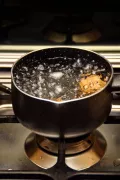Poaching is a cooking technique that involves cooking food in a liquid that is just below the boiling point. It's a popular technique for cooking delicate foods like fish, eggs, and fruit, and it's also a great way to infuse flavors into your dishes. In this article, we'll take a look at the best poaching techniques for beginners, the equipment you'll need, and common mistakes to avoid. By the end of this article, you'll be able to poach like a pro!
What is Poaching?
Poaching is a cooking technique that involves cooking food in a liquid that is just below the boiling point. The liquid is typically flavored with herbs, spices, and other seasonings, which infuses the food with flavor. Poaching is a popular cooking technique for delicate foods like fish, eggs, and fruit because it allows you to cook them without overcooking or undercooking. The result is a tender, flavorful dish that is both healthy and delicious.
Why Poaching is Useful
Poaching is a useful cooking technique because it allows you to cook delicate foods like fish and eggs without overcooking them. When you poach food, the liquid that you cook it in keeps the temperature from rising above the boiling point, which helps to prevent overcooking. Additionally, poaching is a great way to infuse flavors into your dishes. You can use a variety of liquids, including water, broth, wine, and more, to create a flavorful base for your poaching liquid.
Equipment Needed for Poaching
To get started with poaching, you'll need a few pieces of equipment. Here's what you'll need:
- Pot - You'll need a pot that's large enough to hold the food you're poaching and enough liquid to cover it. A heavy-bottomed pot is best because it will distribute heat evenly.
- Thermometer - A thermometer is essential for poaching because it allows you to monitor the temperature of the liquid. You'll want to keep the liquid at a temperature of around 160 to 180 degrees Fahrenheit.
- Slotted Spoon - A slotted spoon is useful for removing the food from the poaching liquid without removing too much of the liquid.
Poaching Liquids
There are many different liquids that you can use for poaching. Water is the most common liquid used for poaching, but you can also use broth, wine, or a combination of liquids. When choosing a poaching liquid, consider the type of food you'll be poaching and the flavors you want to infuse into it. For example, if you're poaching fish, you might want to use a fish stock or a white wine and lemon juice combination.
Poaching Techniques
There are several different poaching techniques, including shallow poaching, deep poaching, and sous vide poaching. Here's a brief overview of each technique:
- Shallow Poaching - In shallow poaching, the food is cooked in a small amount of liquid in a shallow pan. This technique is best for delicate foods like fish and eggs.
- Deep Poaching - In deep poaching, the food is fully submerged in the poaching liquid. This technique is best for tougher cuts of meat, like chicken or pork.
- Sous Vide Poaching - Sous vide poaching involves cooking the food in a vacuum-sealed bag in a water bath that is kept at a precise temperature. This technique is ideal for cooking more delicate foods like fish, eggs, and vegetables, as it allows for precise temperature control.
Poaching Different Types of Food
Different types of food require different poaching techniques. Here are some tips for poaching different types of food:
- Eggs - When poaching eggs, add a splash of vinegar to the poaching liquid to help the egg whites coagulate. Gently crack the egg into a small bowl and then slide it into the poaching liquid. Cook for 2-3 minutes for a runny yolk, or 4-5 minutes for a firmer yolk.
- Fish - When poaching fish, make sure the poaching liquid is well-seasoned with herbs, spices, and aromatics. Poach the fish for 8-10 minutes, or until it's cooked through and flaky.
- Poultry - When poaching chicken or turkey, add vegetables like carrots, onions, and celery to the poaching liquid to infuse flavor into the meat. Poach for 20-30 minutes, or until the meat is fully cooked.
- Fruit - Poaching fruit is a great way to soften it and infuse it with flavor. Use a poaching liquid that complements the fruit, like a spiced wine or a vanilla and sugar syrup. Poach the fruit for 10-15 minutes, or until it's soft and tender.
Common Mistakes When Poaching and How to Avoid Them
Here are some common mistakes to avoid when poaching:
- Overcooking - Overcooking is the most common mistake when poaching. To avoid overcooking, make sure you're using a thermometer to monitor the temperature of the poaching liquid, and remove the food from the liquid as soon as it's cooked through.
- Undercooking - Undercooking is another common mistake. To avoid undercooking, make sure you're using a thermometer to monitor the temperature of the poaching liquid, and adjust the cooking time as needed.
- Flavorless Poaching Liquid - To avoid a flavorless poaching liquid, make sure you're using a well-seasoned liquid that complements the food you're poaching.
Conclusion
Poaching is a versatile cooking technique that is perfect for beginners. With the right equipment and some basic techniques, you can create delicious, healthy, and flavorful dishes that will impress your family and friends. Remember to choose the right poaching liquid for the food you're poaching, monitor the temperature of the liquid with a thermometer, and avoid common mistakes like overcooking or undercooking. With a little practice, you'll be poaching like a pro in no time!










